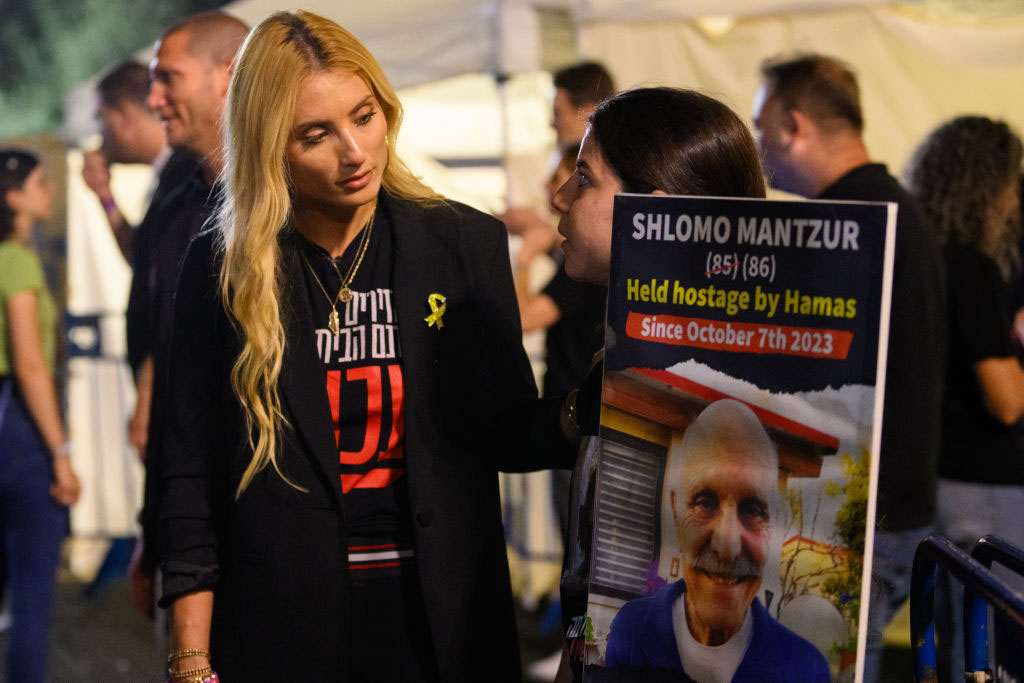
Last week, I described my ambivalence toward Los Angeles, a city I still love, but where I am worried about walking or driving on the streets due to possible attacks by homeless persons.
But while I fear of such attacks, the issue of homeless encampments in my beloved city leaves me feeling sad and hopeless.
I feel compassion for those who live in encampments, especially women. Living on the streets is the very definition of vulnerability. But I’ve also been forced to share my residential street with a homeless encampment for months. Residents have repeatedly contacted our elected officials with pleas to remove the encampment. Last Monday morning, the encampment was cleared. My neighbors and I shared our hopes that the people found housing. We were also relieved that after so many months, our sidewalk was safe and clean again.
Then, 24 hours later, the encampment reappeared exactly where it had been.
Perhaps the issue of encampments is rooted in a fundamental question: Whose rights come first? Those of the homeless persons, who are still human beings and possess the most basic needs for shelter and safety, or the rights of business-owners and residents, including the disabled.
Perhaps the issue of encampments is rooted in a fundamental question: Whose rights come first? Those of the homeless persons, who are still human beings and possess the most basic needs for shelter and safety, or the rights of business-owners and residents, including the disabled.
There’s a lot of Jewish wisdom to be found in the tension between compassion for the homeless and public safety for all. In Judaism, the essence of G-d itself exists in an eternal continuum between chesed (loving kindness and mercy) and gevurah (strength through judgment and enforcing limitations). Judaism understands that some situations require more chesed and others more gevurah.
I’ve been thinking a lot about these two concepts lately, as my neighbors and I have been feeling unseen with regards to our need to live on a safe, clean, ADA-compliant street. It took a long time to have the encampment removed, and one day for it to reappear.
Both residents and the homeless rely on our elected officials, because they are the ones with the power to do something about this. In February, Los Angeles City Council voted to impose its anti-camping law. Known as the Section 41.18 of the Los Angeles Municipal Code, it stipulates that “No person shall obstruct a street, sidewalk, or other public right-of-way” by sitting, sleeping and placing personal property within 500 feet of public spaces. The ordinance was amended to include daycare centers and schools.
Councilmembers have the power to designate certain areas as 41.18 sites, so I reached out to several Councilmembers’ offices to learn more about this. Since taking office, Councilmember Traci Park (CD11), who represents areas including Brentwood, Mar Vista, Marina del Rey, Pacific Palisades and West LA, has designated 12 areas as 41.18 sites. The City Council’s decision to enforce 41.18 came after Park’s election. Her predecessor, Mike Bonin, refused to enforce 41.18 in District 11. Maybe Bonin’s refusal was an example of chesed gone amok.
Councilmember Bob Blumenfield (CD3), who represents Canoga Park, Reseda, Tarzana, Winnetka, and Woodland Hills, has designated 33 areas as 41.18 sites. Representatives from both Park and Blumenfield’s offices told me that 41.18 sites are not a cure for ending homelessness, but a matter of public safety.
I reached out to Councilmember Katy Young Yaroslavsky (CD5), who represents Pico-Robertson, Fairfax, Westwood and Century City, among other areas. She has not designated any areas in her district as 41.18 sites (other City Council members have the same record), but since she is my councilmember, I wanted to ask her a few questions about encampments.
Here’s what I asked Young Yaroslavsky in an email interview:
Jewish Journal: Have you ever put forth a motion to create a 41.18 zone anywhere in your district?
Katy Young Yaroslavsky: No.
JJ: Do you believe 41.18 should be repealed?
KYY: No, I don’t believe it should be repealed. Let me be absolutely clear that I fully support the use of 41.18 at sensitive sites such as schools and daycare centers. As a mom of three, those sites are non-negotiable and I have been consistent in that belief both in my campaign and as a Councilmember. But the fact is that 41.18 sites are not just limited to sensitive areas. Council offices have the authority to designate any public area in the city as a 41.18 zone – and they have done so, creating over 2,000 sites across the city, complicating enforcement of the ordinance.
Earlier this year, I introduced a motion to study the application, enforcement, and effectiveness of 41.18 because we need to know how this policy has been implemented in each council district, what resources are being spent, and whether enforcement is actually helping or hurting our efforts to combat homelessness in Los Angeles. Homelessness is a citywide issue that requires a comprehensive, service-led response.
By law, enforcement of 41.18 must be paired with a credible offer of housing. This motion looks at whether or not that has actually taken place, or if we are simply moving people from block to block. Before I took office, I saw the effect that 41.18 enforcement without credible offers of housing has on residential neighborhoods. Instead of only seeing unhoused people under freeways, we started to see them in residential neighborhoods and in front of homes. Nobody wants that. But that is the reality of enforcing 41.18 without credible offers of housing.
I believe that my motion will give us the data we need to make informed decisions on how to most effectively address homelessness.
JJ: What factors would you consider in designating 41.18 zones, and is the safety of Jewish families walking on the Sabbath, and Jewish children at a multitude of Jewish schools in your district, one of these factors?
KYY: All schools in Los Angeles – including Jewish schools – are considered 41.18 zones, which I support.
[Young Yaroslavsky is referring to the fact that 41.18 is automatically applied to sites that include schools and daycare centers. But it is up to individual Councilmembers to designate other sites, whether freeway underpasses or street intersections, as 41.18 sites].
JJ: When neighborhood groups contact your office about encampments, do you actively work with agencies and law enforcement to have them removed? Is there a different process?
KYY: My dedicated team of three homeless outreach workers works with homeless service and housing providers, LAHSA (The Los Angeles Homeless Services Authority), the Mayor’s office, local institutions, and the LAPD to ensure that no encampments are located within 500 feet of any of the 41.18 school zones on La Cienega. Over the past several months, we coordinated the voluntary relocation of encampments within 500 feet of Ateret Israel preschool, Cheder Menachem (in partnership with Council District 10), Pressman Academy, and the area around Mikvah Esther. We also initiated a major sidewalk cleaning around the Mikvah following the relocation. We also worked with LADOT to resolve an encampment that was located under the Menorah Housing Foundation’s Pico Wooster Senior Housing Center. This encampment had been there for several years and posed a fire hazard for the residents. We also coordinated with LAHSA to move nearly twenty folks living in tents and RVs outside of St. Augustine Church’s school and day care center into housing.
Broadly speaking, we want to move people living in encampments off the street and into housing as quickly as possible. The biggest obstacle is that there isn’t currently enough interim housing in the district. We are working hard to bring those beds online quickly, and will have more news in the coming weeks.
When I asked Young Yaroslavsky about the specific encampment on my street, which is occupied by a male and a female, she said that the man is a member of the local Jewish community. “We have been working with Jewish Family Services and The People’s Concern to find him housing in the area because he attends services at a local synagogue,” Young Yaroslavsky said.
I would love to verify this information, but Young Yaroslavsky’s office did not feel comfortable sharing the name of the synagogue with me so I could follow up on this (without naming the synagogue in print). Young Yaroslavsky’s office instead offered me an interview with the man in the encampment.
I wish I could do it. Maybe another writer would interview him. But I’m deeply uncomfortable with interviewing this individual because for my neighbors, my family and I, this encampment on our residential street has been such a long-term source of pain. Maybe some would say that’s too much gevurah on my part.
This is one of the challenges of our homelessness crisis in this city: Our homeless Angelenos are human beings. We can’t become so desensitized that we completely turn our backs on them.
But our residents are human, too, and we’re growing weary.
I know the encampment on our street won’t last forever. Young Yaroslavsky told me that several Permanent Supportive Housing projects are opening nearby soon and she hopes “this individual will be placed into housing in the coming months.”
For the sake of both chesed and gevurah, I truly hope so.
Tabby Refael is an award-winning writer, speaker and weekly columnist for the Jewish Journal of Greater Los Angeles. Follow her on Twitter and Instagram @TabbyRefael






















 More news and opinions than at a Shabbat dinner, right in your inbox.
More news and opinions than at a Shabbat dinner, right in your inbox.